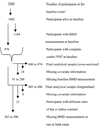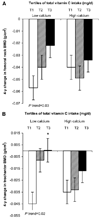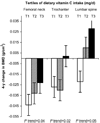High vitamin C intake is associated with lower 4-year bone loss in elderly men
- PMID: 18806103
- PMCID: PMC2752366
- DOI: 10.1093/jn/138.10.1931
High vitamin C intake is associated with lower 4-year bone loss in elderly men
Abstract
Vitamin C is essential for collagen formation and normal bone development. We evaluated associations of total, supplemental, and dietary vitamin C intake with bone mineral density (BMD) at the hip [femoral neck, trochanter], spine, and radial shaft and 4-y BMD change in elderly participants from the Framingham Osteoporosis Study. Energy-adjusted vitamin C intakes were estimated from the Willett FFQ in 1988-89. Mean BMD and 4-y BMD change was estimated, for men and women, by tertile/category of vitamin C intake, adjusting for covariates. We tested for interaction with smoking, calcium, and vitamin E intake. Among 334 men and 540 women, the mean age was 75 y and mean vitamin D intake was 8.25 mug/d (women) and 8.05 mug/d (men). We observed negative associations between total and supplemental vitamin C intake and trochanter-BMD among current male smokers (P-trend = 0.01). Among male nonsmokers, total vitamin C intake was positively associated with femoral neck BMD (P-trend = 0.04). Higher total vitamin C intake was associated with less femoral neck and trochanter-BMD loss in men with low calcium (all P-trend </= 0.03) or vitamin E intakes (all P-trend = 0.03). Higher dietary vitamin C intake tended to be associated with lower femoral neck-BMD loss (P-trend = 0.09). These associations were attenuated but retained borderline significance (P-trend < 0.1) after adjusting for potassium intake (a marker of fruit and vegetable intake), suggesting that vitamin C effects may not be separated from other protective factors in fruit and vegetables. Null associations were observed among women. These results suggest a possible protective role of vitamin C for bone health in older men.
Conflict of interest statement
Author disclosures: S. Sahni, M. T. Hannan, D. Gagnon, J. Blumberg, L. A. Cupples, D. P. Kiel, and K. L. Tucker, no conflicts of Interest.
Figures




Similar articles
-
Protective effect of total and supplemental vitamin C intake on the risk of hip fracture--a 17-year follow-up from the Framingham Osteoporosis Study.Osteoporos Int. 2009 Nov;20(11):1853-61. doi: 10.1007/s00198-009-0897-y. Epub 2009 Apr 4. Osteoporos Int. 2009. PMID: 19347239 Free PMC article.
-
Inverse association of carotenoid intakes with 4-y change in bone mineral density in elderly men and women: the Framingham Osteoporosis Study.Am J Clin Nutr. 2009 Jan;89(1):416-24. doi: 10.3945/ajcn.2008.26388. Epub 2008 Dec 3. Am J Clin Nutr. 2009. PMID: 19056581 Free PMC article.
-
Association of total protein intake with bone mineral density and bone loss in men and women from the Framingham Offspring Study.Public Health Nutr. 2014 Nov;17(11):2570-6. doi: 10.1017/S1368980013002875. Epub 2013 Oct 29. Public Health Nutr. 2014. PMID: 24168918 Free PMC article.
-
Dairy Intake Is Protective against Bone Loss in Older Vitamin D Supplement Users: The Framingham Study.J Nutr. 2017 Apr;147(4):645-652. doi: 10.3945/jn.116.240390. Epub 2017 Mar 1. J Nutr. 2017. PMID: 28250192 Free PMC article.
-
Vitamin C intake in relation to bone mineral density and risk of hip fracture and osteoporosis: a systematic review and meta-analysis of observational studies.Br J Nutr. 2018 Apr;119(8):847-858. doi: 10.1017/S0007114518000430. Br J Nutr. 2018. PMID: 29644950
Cited by
-
Associations between Dietary Antioxidant Vitamin Intake and the Changes in Bone Mass in Chinese Adolescents: A 2.5-Year Longitudinal Study.Nutrients. 2022 Oct 8;14(19):4187. doi: 10.3390/nu14194187. Nutrients. 2022. PMID: 36235841 Free PMC article.
-
Protective effect of total and supplemental vitamin C intake on the risk of hip fracture--a 17-year follow-up from the Framingham Osteoporosis Study.Osteoporos Int. 2009 Nov;20(11):1853-61. doi: 10.1007/s00198-009-0897-y. Epub 2009 Apr 4. Osteoporos Int. 2009. PMID: 19347239 Free PMC article.
-
Evidence of a Positive Link between Consumption and Supplementation of Ascorbic Acid and Bone Mineral Density.Nutrients. 2021 Mar 21;13(3):1012. doi: 10.3390/nu13031012. Nutrients. 2021. PMID: 33801019 Free PMC article. Review.
-
Characteristics associated with bone mineral density responses to alendronate in men.Calcif Tissue Int. 2013 Jun;92(6):548-56. doi: 10.1007/s00223-013-9715-9. Epub 2013 Mar 15. Calcif Tissue Int. 2013. PMID: 23494407 Free PMC article.
-
Sufficient Plasma Vitamin C Is Related to Greater Bone Mineral Density among Postmenopausal Women from the Boston Puerto Rican Health Study.J Nutr. 2021 Dec 3;151(12):3764-3772. doi: 10.1093/jn/nxab291. J Nutr. 2021. PMID: 34510185 Free PMC article.
References
-
- Lanham-New SA. Fruit and vegetables: the unexpected natural answer to the question of osteoporosis prevention? Am J Clin Nutr. 2006;83:1254–1255. - PubMed
-
- Tucker KL, Hannan MT, Kiel DP. The acid-base hypothesis: diet and bone in the Framingham Osteoporosis Study. Eur J Nutr. 2001;40:231–237. - PubMed
-
- Prynne CJ, Mishra GD, O’Connell MA, Muniz G, Laskey MA, Yan L, Prentice A, Ginty F. Fruit and vegetable intakes and bone mineral status: a cross sectional study in 5 age and sex cohorts. Am J Clin Nutr. 2006;83:1420–1428. - PubMed
-
- Tucker KL, Chen H, Hannan MT, Cupples LA, Wilson PW, Felson D, Kiel DP. Bone mineral density and dietary patterns in older adults: the Framingham Osteoporosis Study. Am J Clin Nutr. 2002;76:245–252. - PubMed
-
- Macdonald HM, New SA, Golden MH, Campbell MK, Reid DM. Nutritional associations with bone loss during the menopausal transition: evidence of a beneficial effect of calcium, alcohol, and fruit and vegetable nutrients and of a detrimental effect of fatty acids. Am J Clin Nutr. 2004;79:155–165. - PubMed
Publication types
MeSH terms
Substances
Grants and funding
LinkOut - more resources
Full Text Sources
Medical

